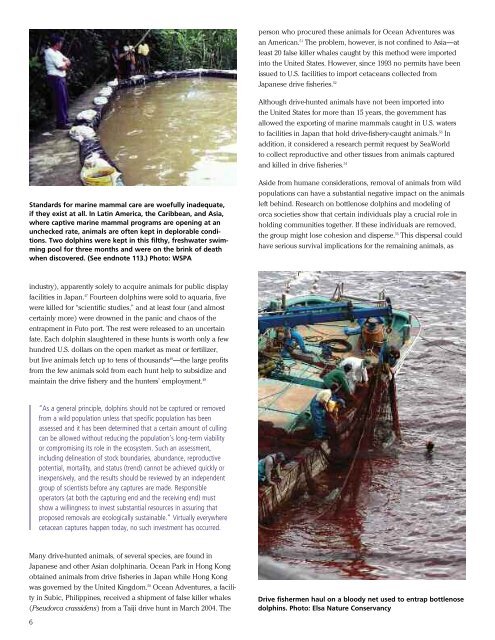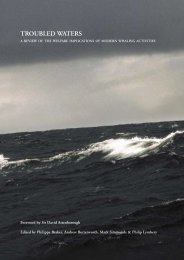The Case against Marine Mammals in Captivity - The Humane ...
The Case against Marine Mammals in Captivity - The Humane ...
The Case against Marine Mammals in Captivity - The Humane ...
- No tags were found...
Create successful ePaper yourself
Turn your PDF publications into a flip-book with our unique Google optimized e-Paper software.
person who procured these animals for Ocean Adventures wasan American. 51 <strong>The</strong> problem, however, is not conf<strong>in</strong>ed to Asia—atleast 20 false killer whales caught by this method were imported<strong>in</strong>to the United States. However, s<strong>in</strong>ce 1993 no permits have beenissued to U.S. facilities to import cetaceans collected fromJapanese drive fisheries. 52Although drive-hunted animals have not been imported <strong>in</strong>tothe United States for more than 15 years, the government hasallowed the export<strong>in</strong>g of mar<strong>in</strong>e mammals caught <strong>in</strong> U.S. watersto facilities <strong>in</strong> Japan that hold drive-fishery-caught animals. 53 Inaddition, it considered a research permit request by SeaWorldto collect reproductive and other tissues from animals capturedand killed <strong>in</strong> drive fisheries. 54Standards for mar<strong>in</strong>e mammal care are woefully <strong>in</strong>adequate,if they exist at all. In Lat<strong>in</strong> America, the Caribbean, and Asia,where captive mar<strong>in</strong>e mammal programs are open<strong>in</strong>g at anunchecked rate, animals are often kept <strong>in</strong> deplorable conditions.Two dolph<strong>in</strong>s were kept <strong>in</strong> this filthy, freshwater swimm<strong>in</strong>gpool for three months and were on the br<strong>in</strong>k of deathwhen discovered. (See endnote 113.) Photo: WSPAAside from humane considerations, removal of animals from wildpopulations can have a substantial negative impact on the animalsleft beh<strong>in</strong>d. Research on bottlenose dolph<strong>in</strong>s and model<strong>in</strong>g oforca societies show that certa<strong>in</strong> <strong>in</strong>dividuals play a crucial role <strong>in</strong>hold<strong>in</strong>g communities together. If these <strong>in</strong>dividuals are removed,the group might lose cohesion and disperse. 55 This dispersal couldhave serious survival implications for the rema<strong>in</strong><strong>in</strong>g animals, as<strong>in</strong>dustry), apparently solely to acquire animals for public displayfacilities <strong>in</strong> Japan. 47 Fourteen dolph<strong>in</strong>s were sold to aquaria, fivewere killed for “scientific studies,” and at least four (and almostcerta<strong>in</strong>ly more) were drowned <strong>in</strong> the panic and chaos of theentrapment <strong>in</strong> Futo port. <strong>The</strong> rest were released to an uncerta<strong>in</strong>fate. Each dolph<strong>in</strong> slaughtered <strong>in</strong> these hunts is worth only a fewhundred U.S. dollars on the open market as meat or fertilizer,but live animals fetch up to tens of thousands 48 —the large profitsfrom the few animals sold from each hunt help to subsidize andma<strong>in</strong>ta<strong>in</strong> the drive fishery and the hunters’ employment. 49“As a general pr<strong>in</strong>ciple, dolph<strong>in</strong>s should not be captured or removedfrom a wild population unless that specific population has beenassessed and it has been determ<strong>in</strong>ed that a certa<strong>in</strong> amount of cull<strong>in</strong>gcan be allowed without reduc<strong>in</strong>g the population’s long-term viabilityor compromis<strong>in</strong>g its role <strong>in</strong> the ecosystem. Such an assessment,<strong>in</strong>clud<strong>in</strong>g del<strong>in</strong>eation of stock boundaries, abundance, reproductivepotential, mortality, and status (trend) cannot be achieved quickly or<strong>in</strong>expensively, and the results should be reviewed by an <strong>in</strong>dependentgroup of scientists before any captures are made. Responsibleoperators (at both the captur<strong>in</strong>g end and the receiv<strong>in</strong>g end) mustshow a will<strong>in</strong>gness to <strong>in</strong>vest substantial resources <strong>in</strong> assur<strong>in</strong>g thatproposed removals are ecologically susta<strong>in</strong>able.” Virtually everywherecetacean captures happen today, no such <strong>in</strong>vestment has occurred.Many drive-hunted animals, of several species, are found <strong>in</strong>Japanese and other Asian dolph<strong>in</strong>aria. Ocean Park <strong>in</strong> Hong Kongobta<strong>in</strong>ed animals from drive fisheries <strong>in</strong> Japan while Hong Kongwas governed by the United K<strong>in</strong>gdom. 50 Ocean Adventures, a facility<strong>in</strong> Subic, Philipp<strong>in</strong>es, received a shipment of false killer whales(Pseudorca crassidens) from a Taiji drive hunt <strong>in</strong> March 2004. <strong>The</strong>Drive fishermen haul on a bloody net used to entrap bottlenosedolph<strong>in</strong>s. Photo: Elsa Nature Conservancy6
















